Rockset hosted a tech be in contact on its new cloud construction that separates storage-compute and compute-compute for real-time analytics. With compute-compute separation throughout the cloud, consumers can allocate a couple of, isolated clusters for ingest compute or query compute while sharing the an identical real-time wisdom.
The controversy was led by the use of Rockset co-founder and CEO Venkat Venkataramani and number one architect Nathan Bronson as they shared how Rockset solves the issue of compute competition by the use of:
- Environment aside streaming ingest and query compute for predictable potency even throughout the face of high-volume writes or reads. This permits consumers to steer clear of overprovisioning to care for bursty workloads
- Supporting a couple of applications on shared real-time wisdom. Rockset separates compute from scorching storage and we could in a couple of compute clusters to accomplish on the shared wisdom.
- Scaling out right through a couple of clusters for high concurrency applications
Beneath, I cover the high-level implementation shared throughout the be in contact and recommend trying out the recording for additonal details on compute-compute separation.
Embedded content material subject material: https://youtu.be/jUDDokvuDLw
What is the problem?
There is a fundamental downside with real-time analytics database design: streaming ingest and occasional latency queries use the an identical compute unit. Shared compute architectures have the good thing about making at the moment generated wisdom right away available for querying. The downside is that shared compute architectures moreover experience competition between ingest and query workloads, leading to unpredictable potency for real-time analytics at scale.
There are 3 not unusual then again insufficient techniques used to take at the downside of compute competition:
Sharding: Scale out the database right through a couple of nodes. Sharding misdiagnoses the problem as working out of compute now not workload isolation. With database sharding, queries can however step on one each different. And, queries for one instrument can step on the other instrument.
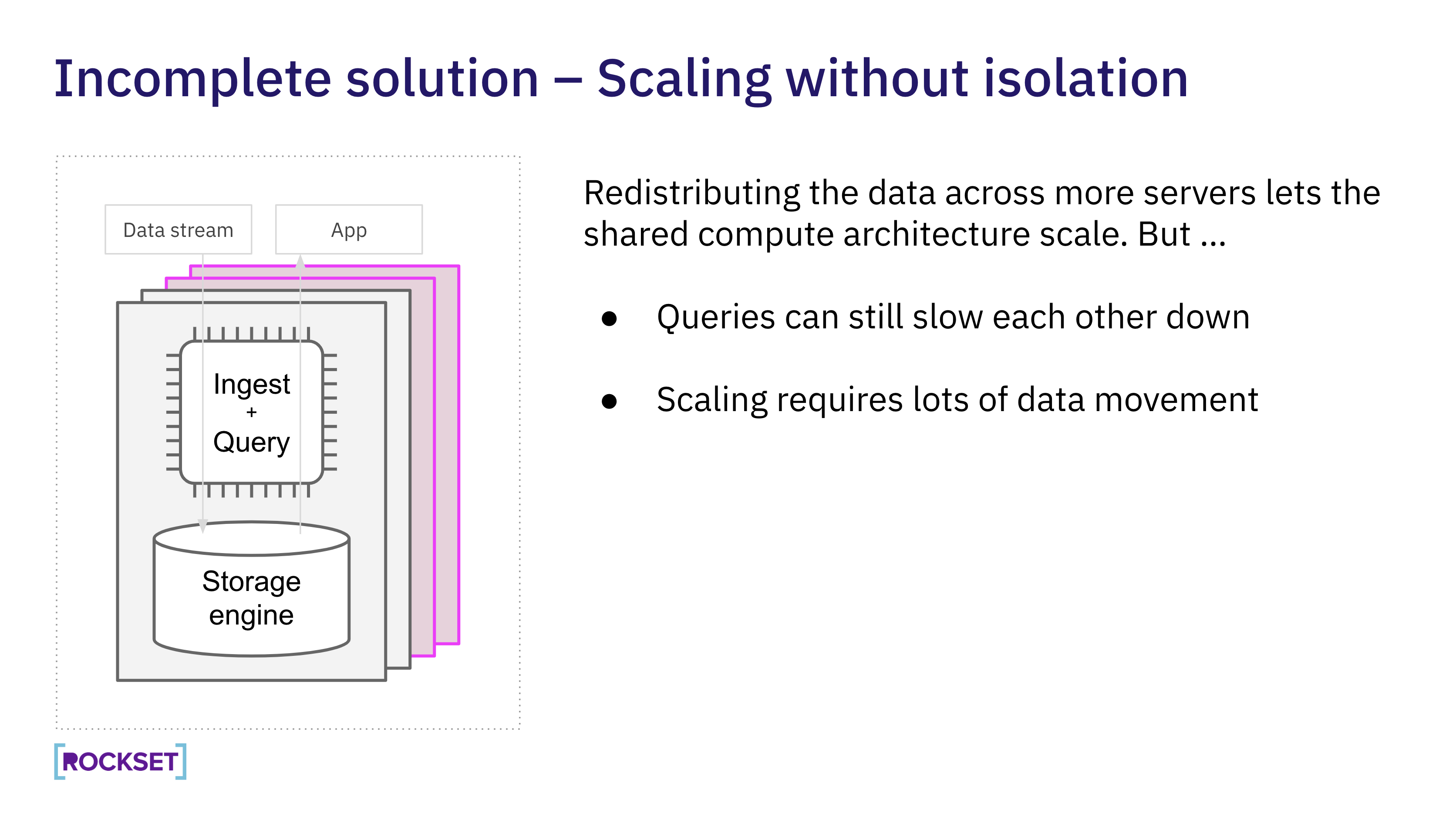
Replicas: Many purchasers attempt to create database replicas for isolation by the use of designating the primary replica for ingestion and secondary replicas for querying. The issue that arises is that there is a lot of duplicate art work required by the use of each replica- each replica will have to process incoming wisdom, store the ideas and index the ideas. And, the additional replicas you’ll have the additional wisdom movement and that leads to a steady scale up or down. Replicas art work at small scale then again this technique in brief falls apart beneath the weight of standard ingestion.

Query without delay from shared storage: Cloud wisdom warehouses have separate compute clusters on shared wisdom, solving the issue of query and storage competition. That construction does now not go a long way enough as it does now not make newly generated wisdom right away available for querying. In this construction, the newly generated wisdom should flush to storage faster than it is made available for querying, together with latency.
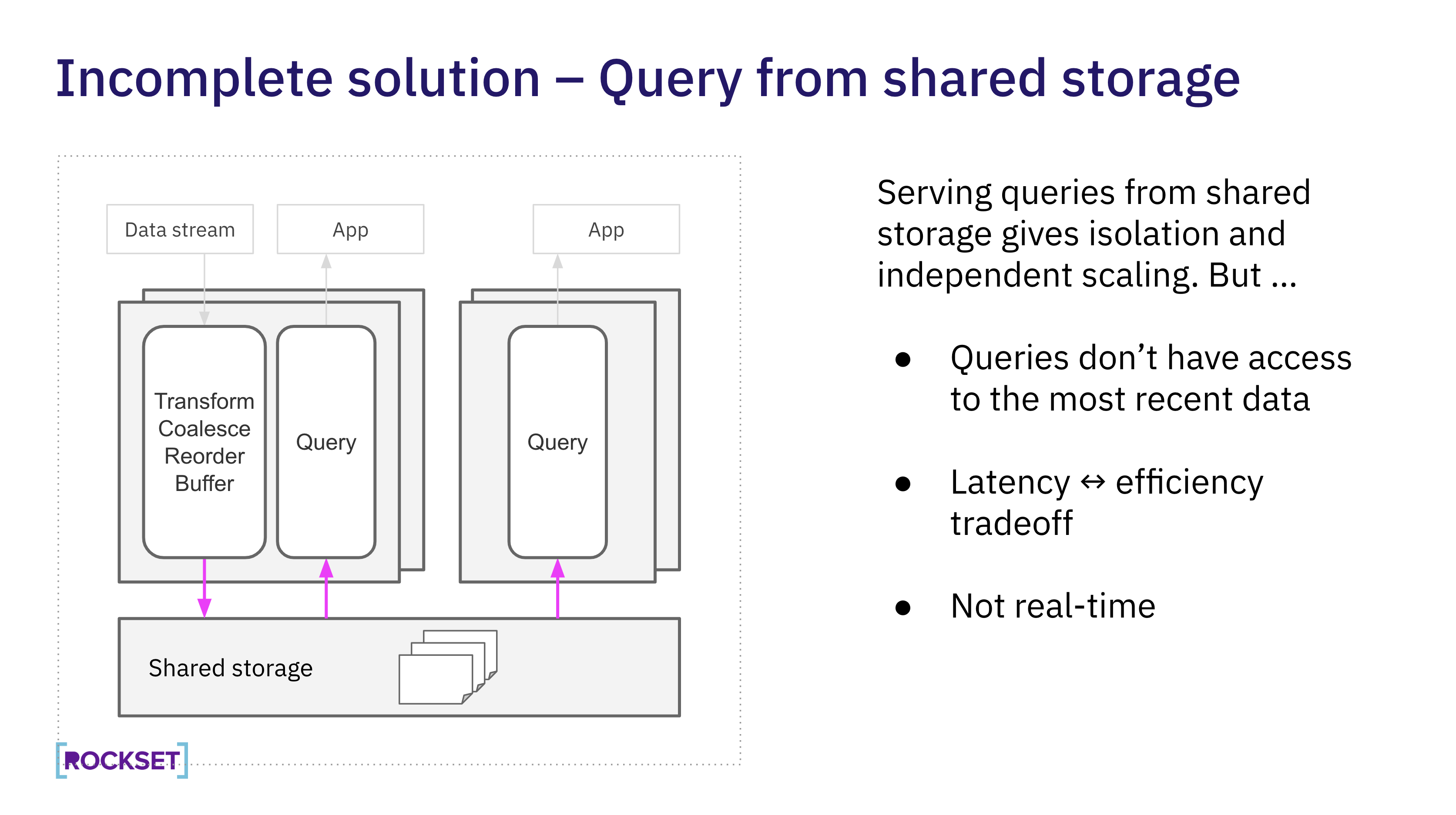
How does Rockset transparent up the problem?
Rockset introduces compute-compute separation for real-time analytics. Now, you are able to have a virtual instance, a compute and memory cluster, for streaming ingestion, queries and a couple of applications.

Letâs delve beneath the hood on how Rockset built this new cloud construction by the use of first keeping apart compute from scorching storage and then keeping apart compute from compute.
Protecting aside compute from scorching storage
First Era: Sharded shared compute
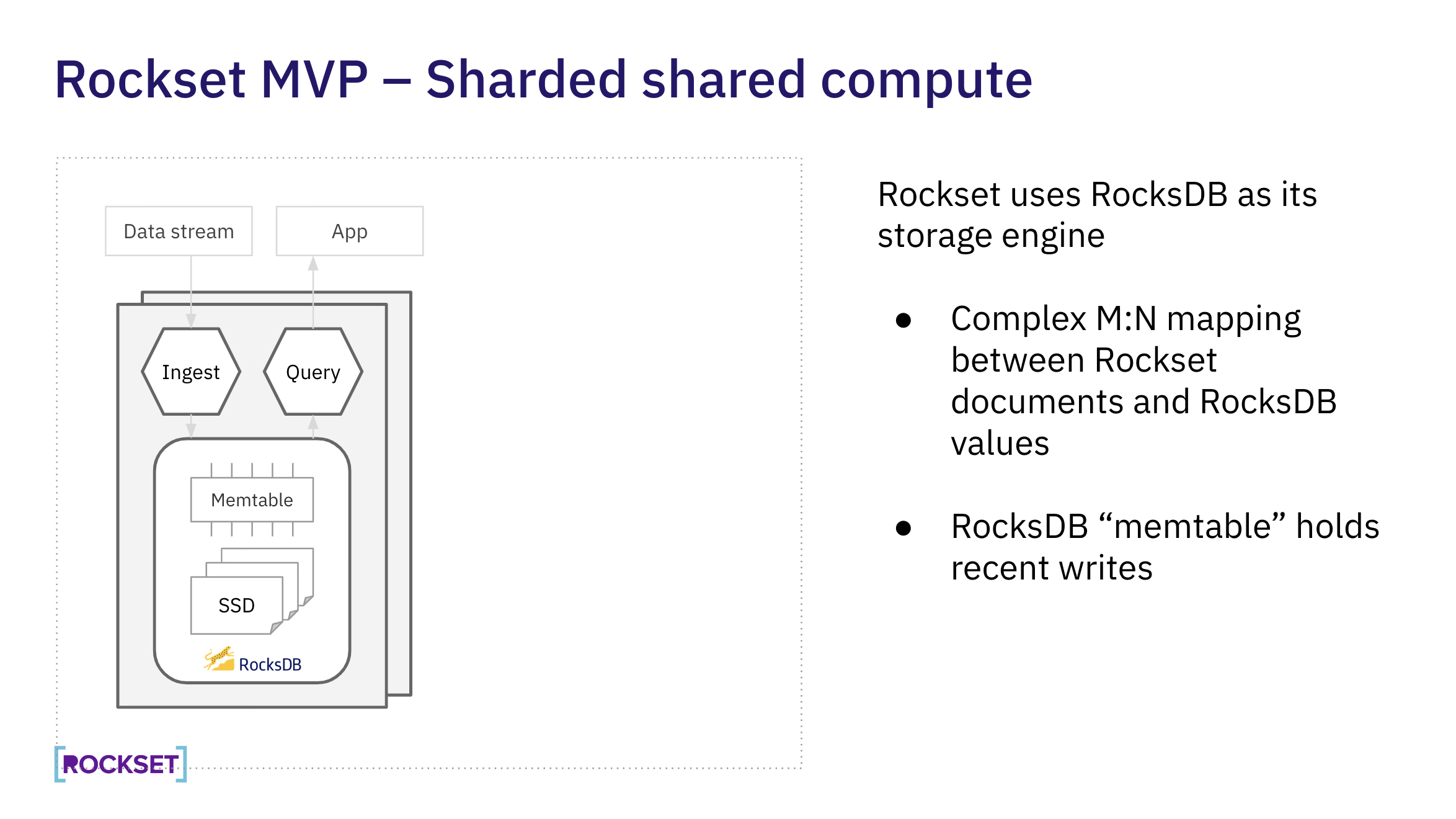
Rockset uses RocksDB as its storage engine beneath the hood. RocksDB is a key-value store complicated by the use of Meta and used at Airbnb, Linkedin, Microsoft, Pinterest, Yahoo and additional.
Each RocksDB instance represents a shard of the total dataset, that implies that the ideas is sent among a large number of RocksDB cases. There is a sophisticated M:N mapping between Rockset forms and RocksDB key-values. Thatâs on account of Rockset has a Converged Index with a columnar store, row store and search index beneath the hood. For instance, Rockset stores many values in a single column within the an identical RocksDB key to support speedy aggregations.
RocksDB memtables are an in-memory cache that stores the latest writes. In this construction, the query execution path accesses the memtable, ensuring that one of the at the moment generated wisdom is made available for querying. Rockset moreover stores an entire replica of the ideas on SSD for quick wisdom get right to use.
2nd Era: Compute-storage separation
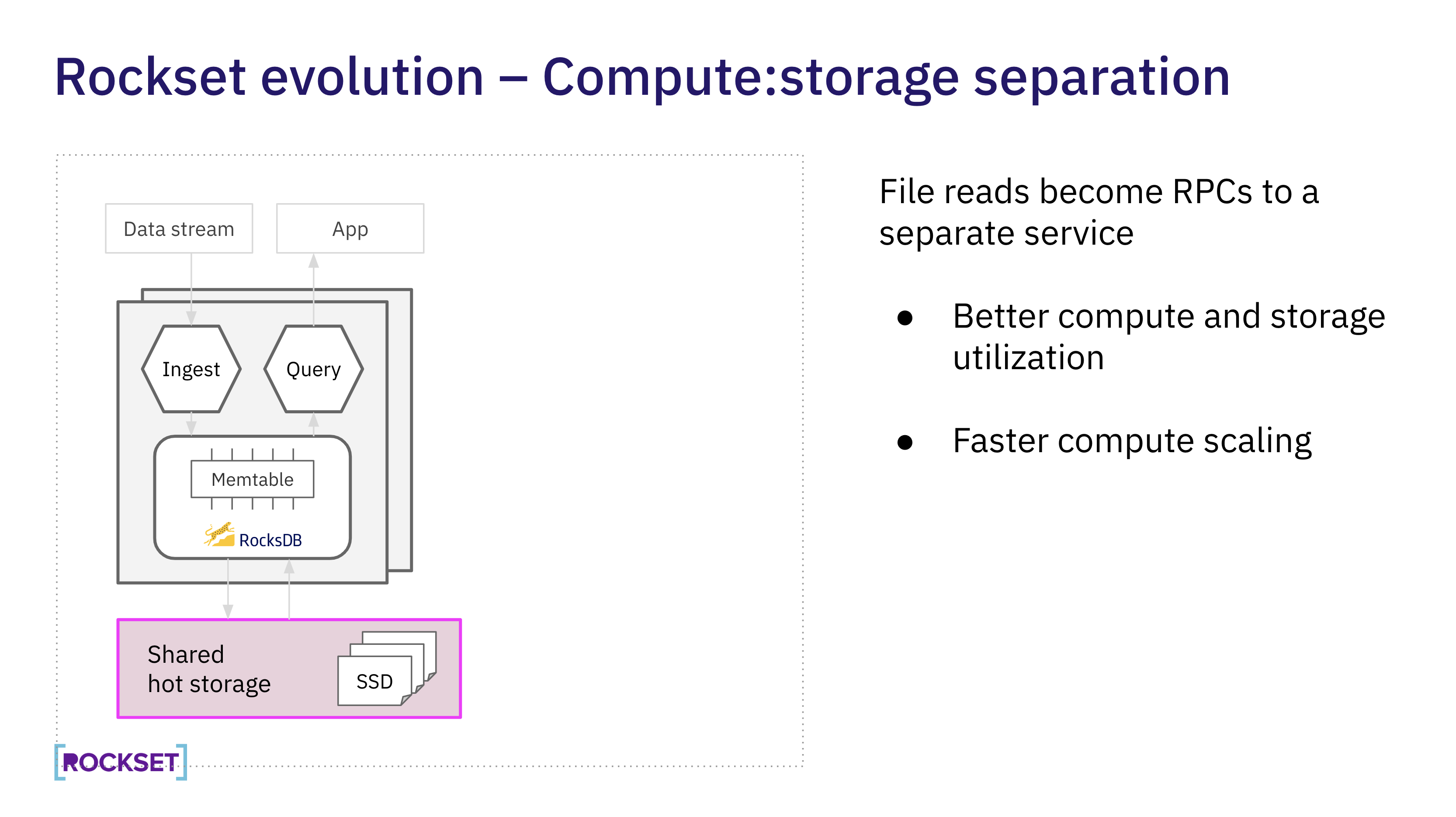
In the second generation construction, Rockset separates compute and scorching storage for faster scale up and down of virtual cases. Rockset uses RocksDBâs pluggable report tool to create a disaggregated storage layer. The storage layer is a shared scorching storage service that is flash-heavy with a direct-attached SSD tier.
third Era: Query from shared storage

Inside the third generation, Rockset lets in the shared scorching storage layer to be accessed by the use of a couple of virtual cases.
The principle virtual instance is authentic time and the secondary cases have a periodic refresh of information. Secondary cases get right to use snapshots from shared scorching storage without getting access to fine-grain updates from the memtables. This construction isolates virtual cases for a couple of applications, making it possible for Rockset to support each and every authentic time and batch workloads effectively.
Protecting aside ingest compute from query compute
Fourth Era: Compute-compute separation

Inside the fourth generation of the Rockset construction, Rockset separates ingest compute from query compute.
Rocket has built upon previous generations of its construction as a way to upload fine-grain replication of RocksDB memtables between a couple of virtual cases. In this leader-follower construction, the manager is in charge of translating ingested wisdom into index updates and showing RocksDB compaction. This frees the follower from just about all of the compute load of ingest.
The manager creates a replication move and sends updates and metadata changes to follower virtual cases. Since follower virtual cases now not need to perform the brunt of the ingestion art work, they use 6-10x a lot much less compute to process wisdom from the replication move. The implementation comes with an information prolong of less than a 100 milliseconds between the manager and follower virtual cases.
Key Design Possible choices
Primer on LSM Trees
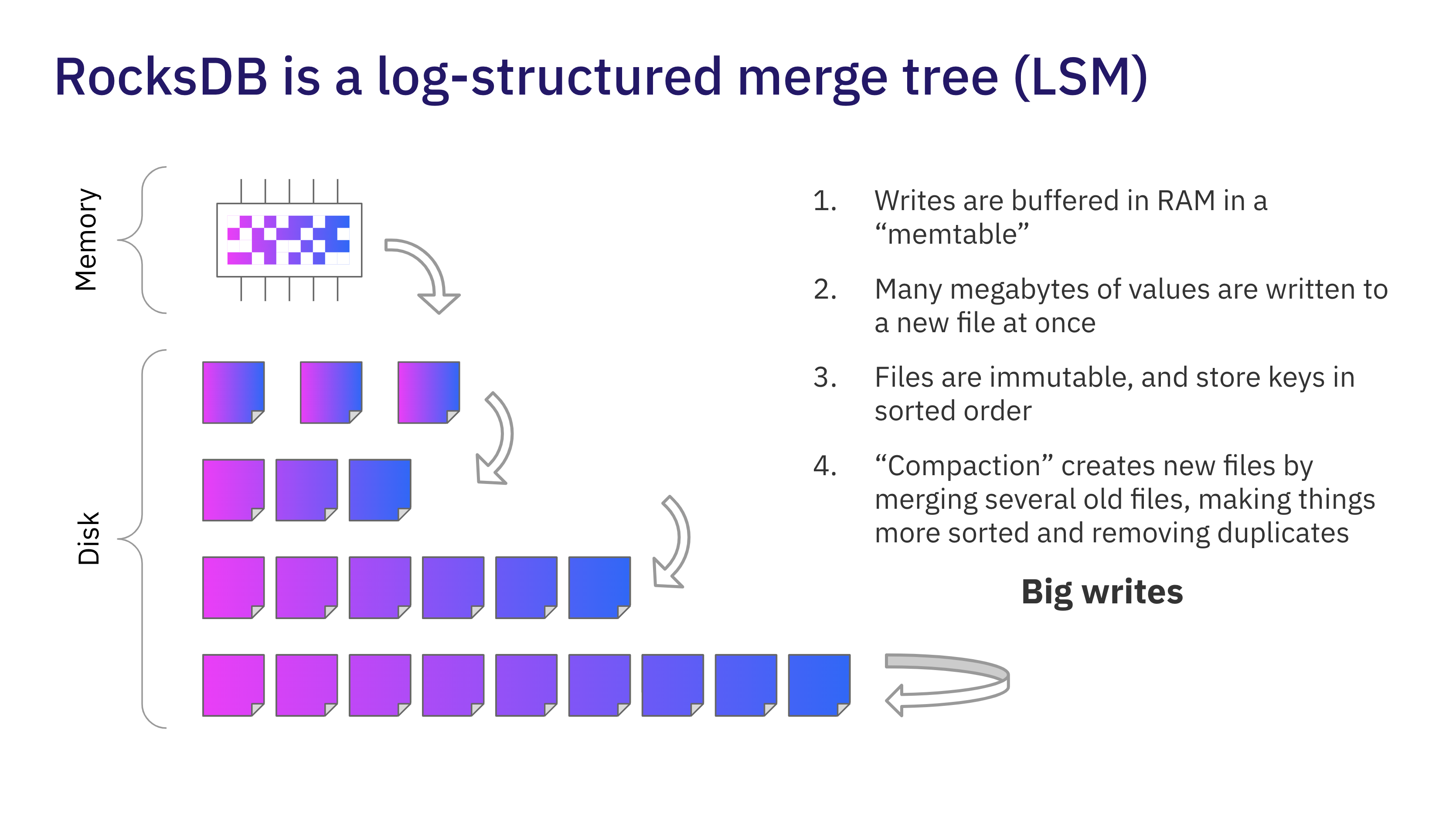
Understanding key design choices of compute-compute separation first requires a basic knowledge of the Log- Structured Merge Tree (LSM) construction in RocksDB. In this construction, writes are buffered in memory in a memtable. Megabytes of writes gather faster than being flushed to disk. Each report is immutable; relatively than updating data in place, new data are created when wisdom is changed. A background compaction process each so ceaselessly merges data to make storage additional surroundings pleasant. It merges earlier data into new data, sorting wisdom and eliminating overwritten values. The advantage of compaction, along side minimizing the storage footprint, is that it reduces the number of puts from which the ideas will have to be be told.
The important serve as of LSM writes is that they are huge and latency-insensitive. This gives us quite a lot of alternatives for making them strong in a cost-effective method.
Degree reads are important for queries that use Rocksetâs inverted indexes. No longer like the large latency-insensitive writes performed by the use of an LSM, point reads result in small reads which might be latency-critical. The core belief of Rocksetâs disaggregated storage construction is that we can similtaneously use two storage tactics, one to get durability and one to get surroundings pleasant speedy reads.
Huge Writes, Small Reads
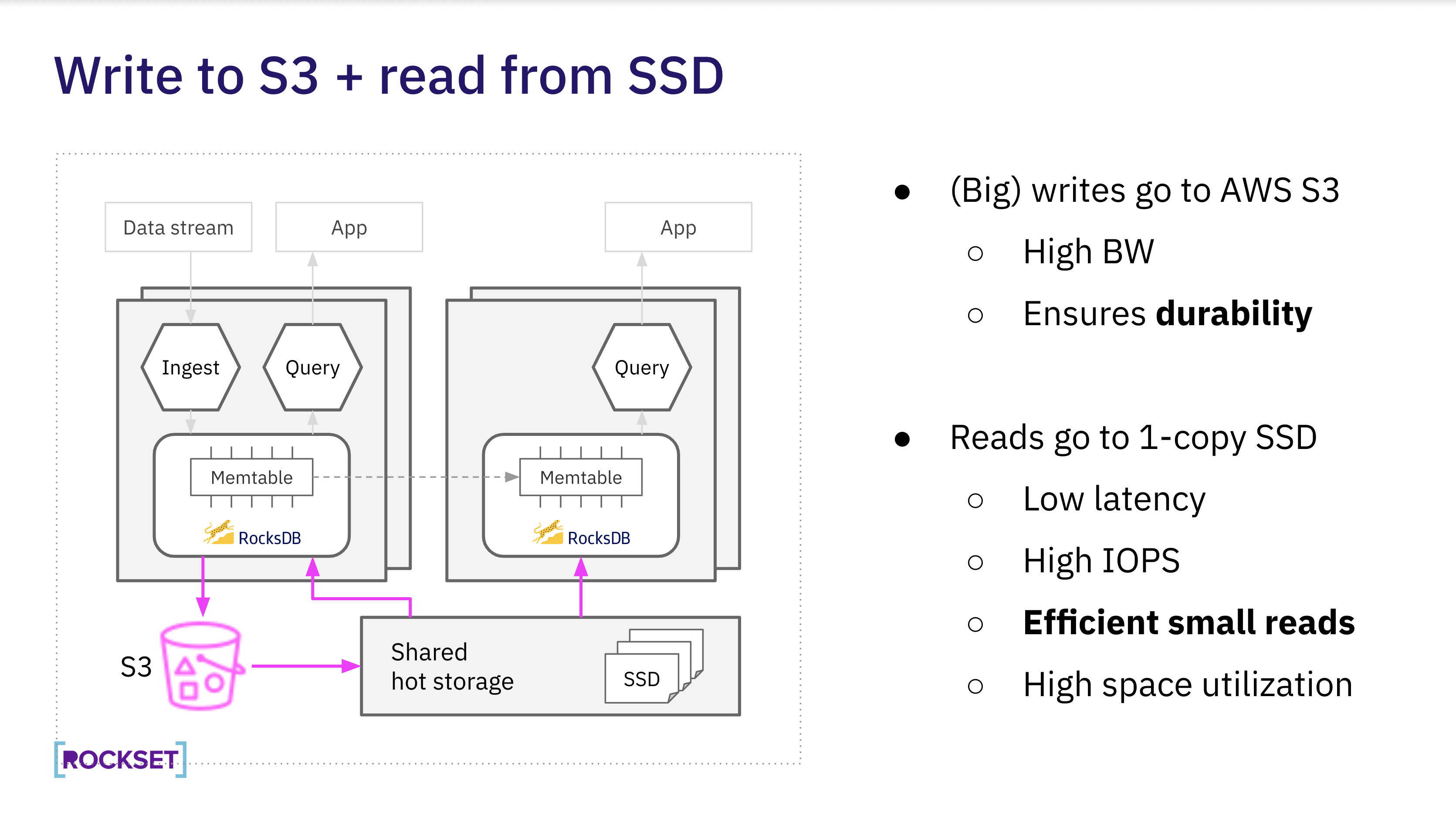
Rockset stores copies of information in S3 for durability and a single replica in scorching storage on SSDs for quick wisdom get right to use. Queries are up to 1000x faster on shared scorching storage than S3.
Just about Very best Scorching Storage Cache
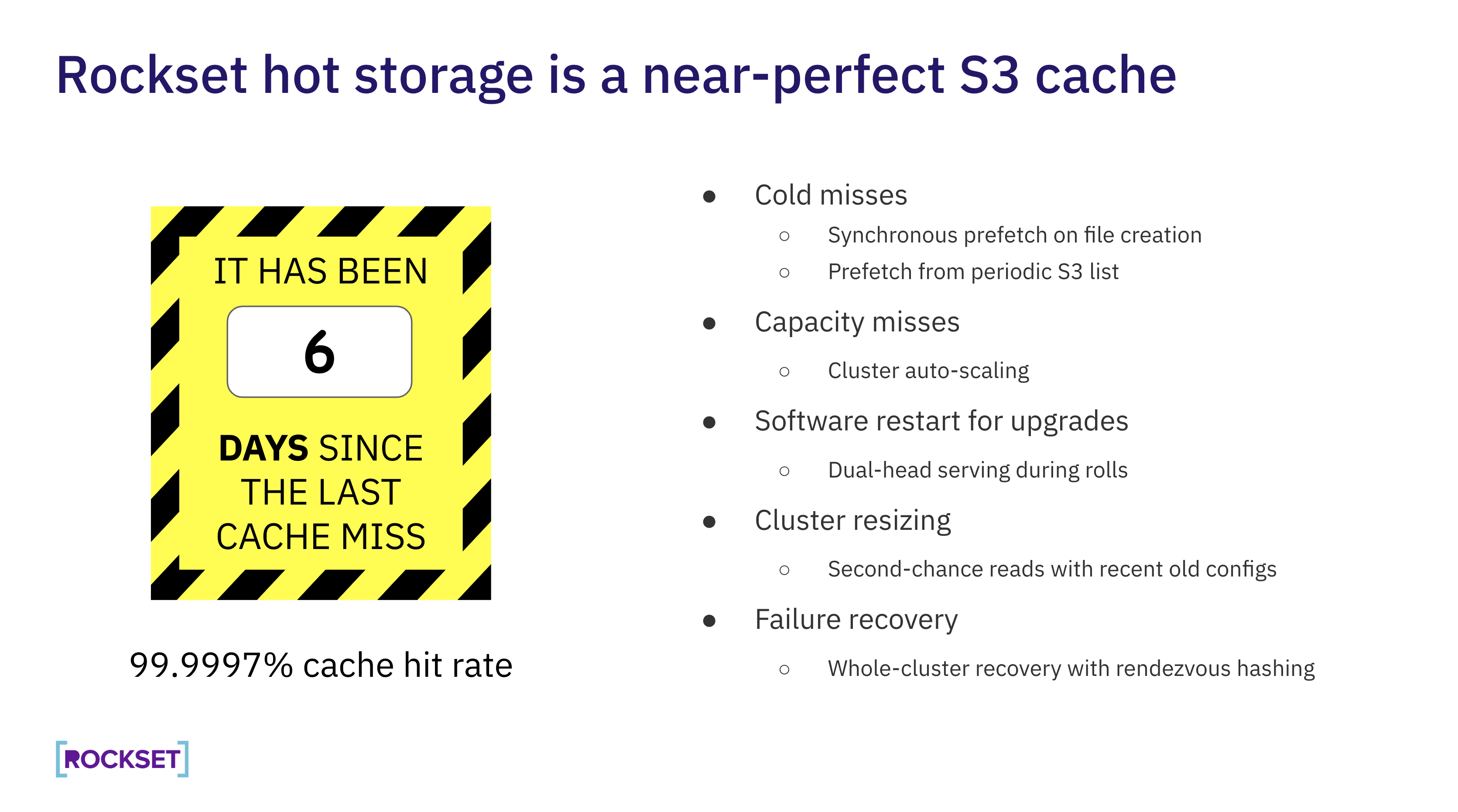
As Rockset is a real-time database, latency problems to our shoppers and we will’t find the money for to depart out gaining access to wisdom from shared scorching storage. Rockset scorching storage is a near-perfect S3 cache. Most days there are not any cache misses anyplace in our production infrastructure.
Proper right hereâs how Rockset solves for potential cache misses, at the side of:
- Cold misses: To verify wisdom is all the time available throughout the cache, Rockset does a synchronous prefetch on report introduction and scans S3 on a periodic basis.
- Capacity misses: Rockset has auto-scaling to ensure that the cluster does now not run out of space. As a belt-and-suspenders method, if we do run out of disk space we evict the least-recently accessed wisdom first.
- Tool restart for upgrades: Dual-head serving for the rollout of latest tool. Rockset brings up the new process and makes positive that it is online faster than shutting down the former fashion of the service.
- Cluster resizing: If Rockset cannot to seek out the indexed wisdom right through resizing, it runs a second-chance be told the usage of the former cluster configuration.
- Failure recovery: If a single system fails, we distribute the recovery right through all the machines throughout the cluster the usage of rendezvous hashing.
Consistency and Durability
Rocksetâs leader-follower construction is designed to be consistent and durable although there are a couple of copies of the ideas. One way Rockset sidesteps some of the important challenging scenarios of constructing a continuing and durable allotted database is by the use of the usage of persistent and durable infrastructure beneath the hood.
Leader-Follower Construction
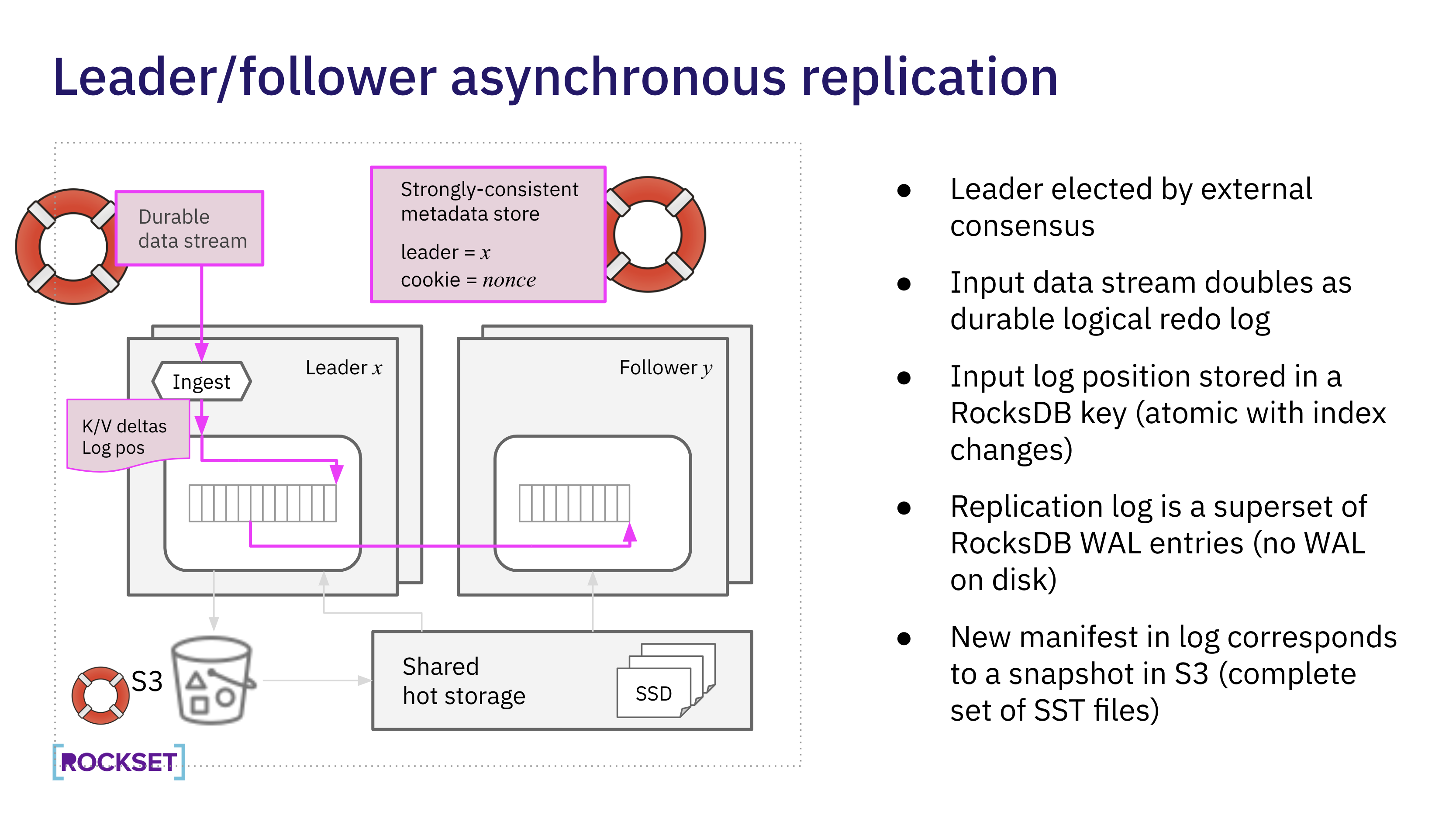
Inside the leader-follower construction, the ideas move feeding into the ingest process is continuous and durable. It is effectively a strong logical redo log, enabling Rockset to go back to the log to retrieve newly generated wisdom in terms of a failure.
Rockset uses an external strongly-consistent metadata store to perform leader election. Each time a pace-setter is elected it possible choices a cookie, a random nonce that is built-in throughout the S3 object path for all of the actions taken by the use of that leader. The cookie promises that despite the fact that an earlier leader remains to be working, its S3 writes wonât interfere with the new leader and its actions will be ignored by the use of enthusiasts.
The input log position from the strong logical redo log is stored in a RocksDB key to ensure exactly-once processing of the input move. Because of this that it is safe to bootstrap a pace-setter from any recent official RocksDB state.
The replication log is a superset of the RocksDB write-ahead logs, augmenting WAL entries with with additional events very similar to leader election. Key/price changes from the replication log are inserted without delay into the memtable of the follower. When the log implies that the manager has written the memtable to disk, however, the follower can merely get began finding out the report created by the use of the manager â the manager has already created the report on disaggregated storage. Similarly, when the follower gets notification {{that a}} compaction has finished, it will merely get began the usage of the new compaction results without delay without doing any of the compaction art work.
In this construction, the shared scorching storage accomplishes just-in-time physically replication of the bytes of RocksDBâs SST data, at the side of the physically report changes that outcome from compaction, while the manager/follower replication log carries best possible logical changes. Along side the strong input wisdom move, this shall we the manager/follower log be lightweight and non-durable.
Bootstrapping a pace-setter

Inside the leader-follower construction, the ideas move feeding into the ingest process is continuous and durable. It is effectively a strong logical redo log, enabling Rockset to go back to the log to retrieve newly generated wisdom in terms of a failure.
Rockset uses an external strongly-consistent metadata store to perform leader election. Each time a pace-setter is elected it possible choices a cookie, a random nonce that is built-in throughout the S3 object path for all of the actions taken by the use of that leader. The cookie promises that despite the fact that an earlier leader remains to be working, its S3 writes wonât interfere with the new leader and its actions will be ignored by the use of enthusiasts.
The input log position from the strong logical redo log is stored in a RocksDB key to ensure exactly-once processing of the input move. Because of this that it is safe to bootstrap a pace-setter from any recent official RocksDB state.
The replication log is a superset of the RocksDB write-ahead logs, augmenting WAL entries with with additional events very similar to leader election. Key/price changes from the replication log are inserted without delay into the memtable of the follower. When the log implies that the manager has written the memtable to disk, however, the follower can merely get began finding out the report created by the use of the manager â the manager has already created the report on disaggregated storage. Similarly, when the follower gets notification {{that a}} compaction has finished, it will merely get began the usage of the new compaction results without delay without doing any of the compaction art work.
In this construction, the shared scorching storage accomplishes just-in-time physically replication of the bytes of RocksDBâs SST data, at the side of the physically report changes that outcome from compaction, while the manager/follower replication log carries best possible logical changes. Along side the strong input wisdom move, this shall we the manager/follower log be lightweight and non-durable.
Together with a follower
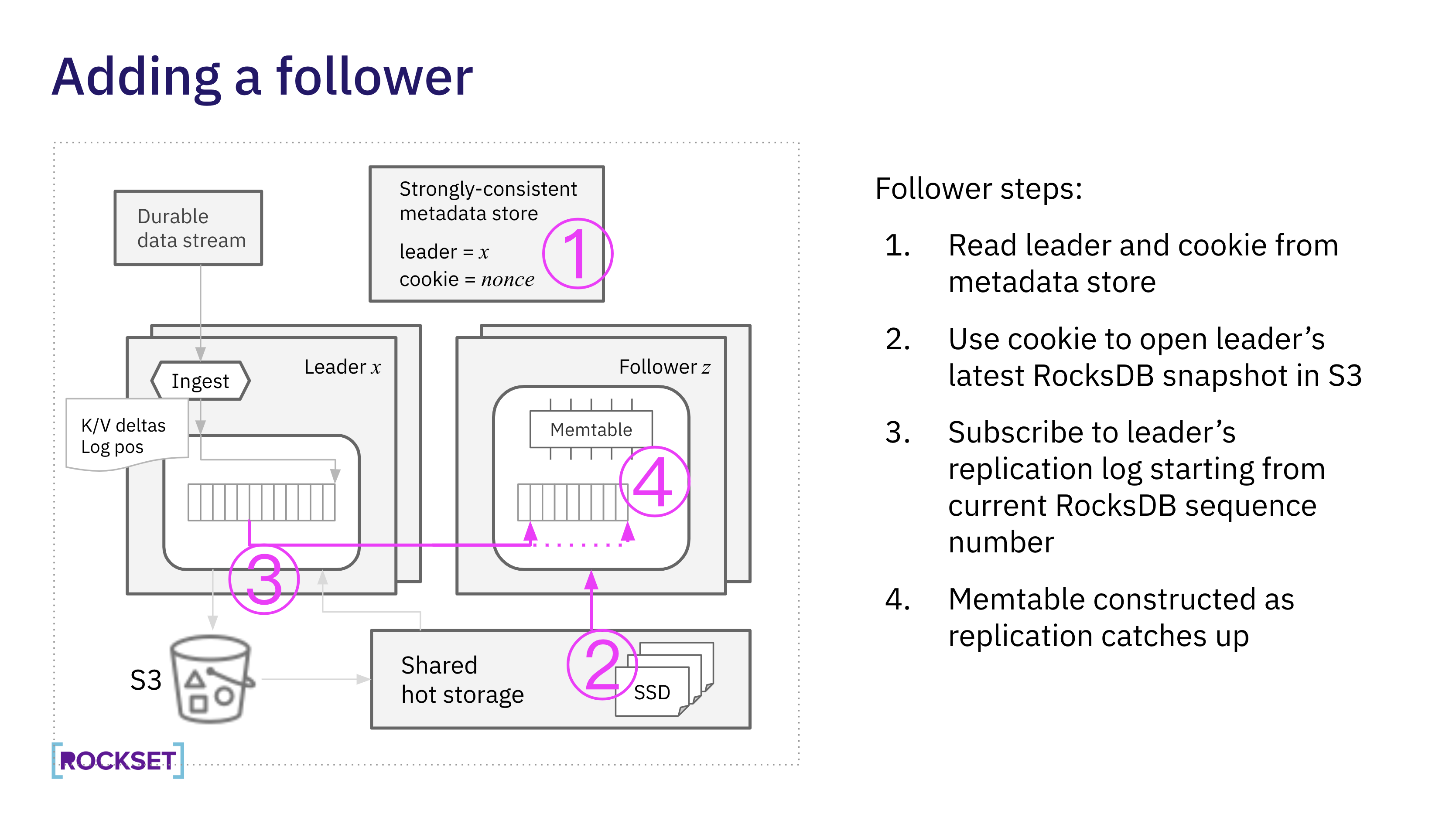
Lovers use the managerâs cookie to hunt out the latest RocksDB snapshot in shared scorching storage and subscribe to the managerâs replication log. The follower constructs a memtable with one of the at the moment generated wisdom from the replication log of the manager.
Precise-International Implications
Weâve walked all through the implementation of compute-compute separation and how it solves for:
Streaming ingest and query compute isolation:The problem of an information flash flood monopolizing your compute and jeopardizing your queries is solved with isolation. And, the an identical on the query facet in case you have a burst of consumers on your instrument. Scale independently so you are able to right kind duration the virtual instance to your ingest or query workload.
A couple of applications on shared real-time wisdom: You’ll be able to spin up or down any number of virtual cases to segregate instrument workloads. A couple of production applications can share the an identical dataset, eliminating the need for replicas.
Linear concurrency scaling: You right-size the virtual instance in step with query latency in step with single query potency. Then you are able to autoscale for concurrency, spinning up the an identical virtual instance duration for linear scaling.
We merely scratched the outside on Rocksetâs compute-compute construction for real-time analytics. You’ll be able to learn additional by the use of staring on the tech be in contact or seeing how the construction works in a step-by-step product demonstration.